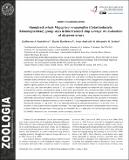Files in this item
Humpback whale Megaptera novaeangliae (Cetartiodactyla: Balaenopteridae) group sizes in line transect ship surveys : an evaluation of observer errors
Item metadata
| dc.contributor.author | Bortolotto, Guilherme A. | |
| dc.contributor.author | Danilewicz, Daniel | |
| dc.contributor.author | Andriolo, Artur | |
| dc.contributor.author | Zerbini, Alexandre Novaes | |
| dc.date.accessioned | 2019-10-14T15:30:04Z | |
| dc.date.available | 2019-10-14T15:30:04Z | |
| dc.date.issued | 2016-05-06 | |
| dc.identifier | 261541704 | |
| dc.identifier | 84920421-2b79-4763-8fb1-a9ba5337b8b1 | |
| dc.identifier | 84966335526 | |
| dc.identifier | 000376449900009 | |
| dc.identifier.citation | Bortolotto , G A , Danilewicz , D , Andriolo , A & Zerbini , A N 2016 , ' Humpback whale Megaptera novaeangliae (Cetartiodactyla: Balaenopteridae) group sizes in line transect ship surveys : an evaluation of observer errors ' , Zoologia , vol. 33 , no. 2 , e20150133 , pp. 1-5 . https://doi.org/10.1590/S1984-4689zool-20150133 | en |
| dc.identifier.issn | 1984-4689 | |
| dc.identifier.other | ORCID: /0000-0002-5343-6575/work/63046001 | |
| dc.identifier.uri | https://hdl.handle.net/10023/18664 | |
| dc.description.abstract | Accurate estimates of group sizes through line transect sampling methods are important to correctly ascertain the abundance of animals that occur in groups. Since the average observed group size is a component of the distance sampling formula, bias in these data leads to biased abundance estimates. This study aimed to evaluate the potential errors in group size estimation during line transect ship surveys to estimate abundances of the humpback whale, Megaptera novaeangliae (Borowski 1781). In a research cruise along the Brazilian coast, an experiment to collect group size information was conducted from two different sighting platforms on the same vessel. Group sizes were recorded by primary observers at first sighting (PO1) and, in some cases, after some time (PO2). A tracker (T) was located on a higher platform to estimate the sizes of groups detected by the primary observers, but tracked one group at a time until it passed abeam. Thus, the dedicated effort to obtain multiple group counts (i.e. higher platform, more time and no responsibility for detecting new groups) was expected to provide more accurate numbers. PO2 estimates were compared with PO1 estimates, and T estimates were compared with both PO1 and PO2. Additionally, ratios between T and both PO2 (R1) and PO1 (R2), and between PO2 and PO1 (R3) were calculated. To investigate a possible improvement in abundance estimates, a correction factor (CF) was computed from the ratio of T and PO2 means. Primary observer self-correction (= 1.60, CV% = 70.3) was statistically similar to the correction for the tracker (= 1.62, CV% = 84.1). CF resulted in 1 and would not improve abundance estimates. This study supports that observers conducting line transect surveys on large whales have the potential to provide group size information that is as adequate as the correction procedure adopted. | |
| dc.format.extent | 5 | |
| dc.format.extent | 839228 | |
| dc.language.iso | eng | |
| dc.relation.ispartof | Zoologia | en |
| dc.subject | Abundance | en |
| dc.subject | Bias | en |
| dc.subject | Conservation | en |
| dc.subject | distance sampling | en |
| dc.subject | Mysticetus | en |
| dc.subject | GC Oceanography | en |
| dc.subject | QH301 Biology | en |
| dc.subject | NDAS | en |
| dc.subject.lcc | GC | en |
| dc.subject.lcc | QH301 | en |
| dc.title | Humpback whale Megaptera novaeangliae (Cetartiodactyla: Balaenopteridae) group sizes in line transect ship surveys : an evaluation of observer errors | en |
| dc.type | Journal article | en |
| dc.contributor.institution | University of St Andrews. School of Biology | en |
| dc.identifier.doi | https://doi.org/10.1590/S1984-4689zool-20150133 | |
| dc.description.status | Peer reviewed | en |
This item appears in the following Collection(s)
Items in the St Andrews Research Repository are protected by copyright, with all rights reserved, unless otherwise indicated.

